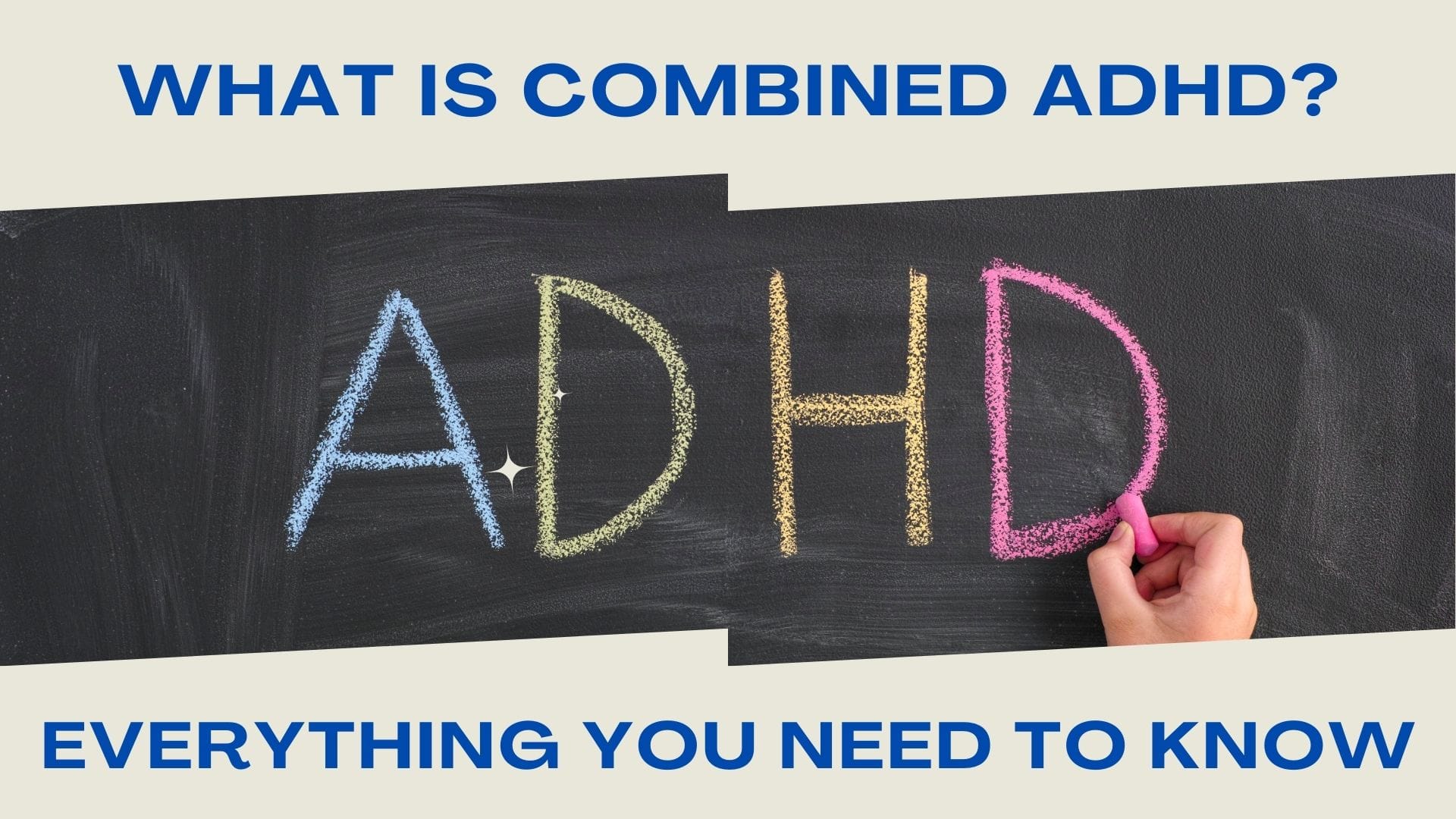What is Combined ADHD? Everything you need to know.

Imagine trying to live with a racing mind while distractions constantly pull your attention away. Many individuals with Combined ADHD experience this challenge. Combined ADHD includes symptoms of both inattention and hyperactivity-impulsivity. Understanding this complex condition is essential for better support and management.
Combined ADHD is the most prominent of the three ADHD subtypes. The symptoms of Combined ADHD can appear in various forms, resulting in significant challenges in academic, social, and professional environments. Understanding the signs, causes, and treatments can help those affected and their loved ones create a supportive environment.
This blogpost explores the different ADHD subtypes with an emphasis on the Combined ADHD presentation. The goal of this blogpost is to improve the awareness needed for understanding and supporting those with combined ADHD.
The Three Subtypes of ADHD
Attention Deficit Hyperactivity Disorder (ADHD) is classified into three main subtypes:
- Predominantly Inattentive Presentation (ADHD-I)
- Predominantly Hyperactive-Impulsive Presentation (ADHD-HI)
- Combined Presentation (ADHD-C)
Each subtype is characterised by a distinct set of symptoms that might manifest differently in each individual. Understanding these classifications is essential for accurate diagnosis and effective treatment.
Predominantly Inattentive Presentation (ADHD-I)
The predominantly inattentive type affects around 20-30% of those with ADHD. It is characterised by significant difficulties with attention and focus. Individuals may struggle with organisation, become easily distracted, and exhibit problems with effectively completing tasks.
This subtype is often overlooked, especially in girls, who may show signs of inattention without the hyperactivity typical of ADHD. As a result, they may fall through the cracks, be misdiagnosed, or go undiagnosed.
Predominantly Hyperactive-Impulsive Presentation (ADHD-HI)
The predominantly hyperactive-impulsive type is the least common subtype, making up about 5-10% of cases. It is characterised by excessive movement, fidgeting, and impulsive actions. People in this group may interrupt others, struggle to wait their turn, and act without thinking about the consequences.
This type is more commonly recognised in boys, who display overt hyperactive behaviours that might be disruptive in classroom settings.
Combined Presentation (ADHD-C)
Lastly, Combined presentation is the most prominent subtype, comprising about 50-75% of all ADHD cases. As the name suggests, it combines symptoms from both the inattentive and hyperactive-impulsive types.
People with the combined type show a wider range of symptoms, highlighting the need for healthcare providers to conduct thorough assessments to create effective treatment plans.
The interaction of these symptoms can pose substantial obstacles across various aspects of life, including academic success, personal relationships, and financial stability.
Understanding Combined ADHD
Attention Deficit Hyperactivity Disorder (ADHD) is a neurodevelopmental disorder that might significantly impact an individual's life. ‘Combined ADHD’ or ‘Combined Type’ is the most prominent ADHD form.
This subtype, as the name suggests, involves a combination of hyperactivity, impulsivity, and inattention. Combined ADHD includes symptoms of both ‘inattention’ type and ‘hyperactivity-impulsivity’ type.
Common Symptoms of Combined ADHD
- Forgetfulness
- Restlessness
- Disorganisation
- Impulsivity
Impact on Daily Life
- Challenges in performing daily tasks
- Struggling with quiet activities that require sustained focus
- Difficulty maintaining social and organisational skills
The Combined type of ADHD is notably the most common type, affecting 50-75% of all ADHD cases. Managing this condition involves a multifaceted treatment plan, typically incorporating medication, behavioural therapy, and lifestyle modifications.
Remember, ADHD is a developmental disorder and not a deficit of willpower. Those living with it can thrive with the right support and understanding.
Symptoms of Combined ADHD
Combined ADHD includes symptoms of hyperactivity, impulsivity, and inattention, posing a complex challenge for those affected by this subtype. People with Combined ADHD face various challenges that can impact their performance in school, work, and social situations.
Those with Combined ADHD may exhibit a restlessness that overshadows their day-to-day life. For example, children might have a hard time sitting still or refraining from excessive talking. Adults can also struggle with self-control in conversations, often interrupting or speaking at inappropriate times.
Although hyperactivity may decrease with age, leading to subtler presentations in adults, the struggles with organisation and focus generally persist. Disorganisation makes it difficult to keep track of obligations and priorities, leading to forgotten tasks and missed deadlines.
Each person experiences the intensity and occurrence of Combined ADHD symptoms differently, regardless of the severity of the condition. Symptoms can change over time. For instance, hyperactivity may decrease from childhood to adolescence, while inattentiveness may become more noticeable as responsibilities grow.
Inattentive Symptoms in Combined ADHD
People with ‘Combined Presentation’ exhibit symptoms that revolve around inattentiveness. This translates to often overlooking details, resulting in careless mistakes in school and work.
These individuals often struggle to maintain focus on tasks and hobbies for extended periods, leading to incomplete projects and a habit of frequently shifting their attention to new activities without finishing what they started.
Subtle cues, like seeming disengaged in conversations, often lead to misunderstandings and awkward social interactions.
Hyperactive-Impulsive Symptoms in Combined ADHD
Combined ADHD includes hyperactive-impulsive symptoms, adding another challenging aspect for those with this subtype. Excessive movement is a common behaviour in children. Similarly, adults often find it hard to sit still in calm settings like classrooms or offices.
Constant fidgeting or restlessness can hinder focus, leading to unfinished tasks and poor information retention.
Impulsivity takes many forms, such as speaking or acting without thought for consequences, or a general disregard for potential dangers. Impulsive individuals can disrupt relationships and learning environments by interrupting others.
This subtype is also associated with making quick, often poor decisions with little concern for potential consequences. These behaviours are often more noticeable in childhood but can persist into adulthood, necessitating strategies to manage their impact on daily life.
Impact on Daily Life
Untreated ADHD can negatively impact academics, career growth, relationships, and daily life. For adults, failure to address ADHD symptoms exacerbates challenges like time management, forgetfulness, disorganisation, and emotional regulation.
This could manifest in missed deadlines, cluttered workspaces, and unpredictable mood swings. ADHD can hinder children's social and academic development, harming their self-esteem and making peer relationships more difficult if not addressed.
For children, symptoms can be misinterpreted as disregard for rules or laziness, rather than manifestations of a neurodevelopmental disorder. This misinterpretation can lead to lower self-worth and increased sensitivity to criticism.
ADHD affects both children and adults, leading to lower self-esteem and increased sensitivity to criticism due to its ongoing challenges and social effects. These factors highlight the importance of effective treatment and support for managing daily life with combined ADHD.
Approximately 60-70% of adults with ADHD also have comorbid disorders, like anxiety or mood disorders, which makes it difficult to manage daily activities and leisure.
ADHD's lasting effects on social skills, organisation, and daily tasks can result in ongoing feelings of underachievement and dissatisfaction. Recognising and addressing ADHD's impact is crucial in mitigating these profound effects on an individual's daily experiences.
The Importance of Understanding Combined ADHD
In conclusion, understanding the complexities of combined ADHD, the most common type of Attention Deficit Hyperactivity Disorder, is essential for those impacted and their support systems.
This type of ADHD is marked by ongoing inattention and hyperactivity-impulsivity, making daily tasks and social interactions difficult. It is important to understand that symptoms can manifest differently across life stages, potentially altering the impact on social, occupational, and family life from childhood through adulthood.
Effective management calls for a comprehensive treatment plan that may incorporate medication, behavioural therapy, and lifestyle changes. Such a personalised approach can enhance daily tasks, organisational skills, and social skills, enabling individuals to thrive despite the disorder.
Raising awareness and implementing targeted strategies is essential for overcoming the challenges presented by combined ADHD. A deeper understanding of this condition can empower individuals with combined ADHD to lead more fulfilling and thriving lives.
